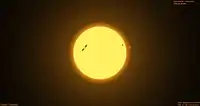HD 13189
HD 13189 is an 8th magnitude star in Triangulum constellation.
| Observation data Epoch J2000.0 Equinox J2000.0 | |
|---|---|
| Constellation | Triangulum |
| Right ascension | 02h 09m 40.1723s[1] |
| Declination | +32° 18′ 59.161″[1] |
| Apparent magnitude (V) | +7.57[2] |
| Characteristics | |
| Spectral type | K1II-III[3] |
| Astrometry | |
| Radial velocity (Rv) | 25.39[4] km/s |
| Proper motion (μ) | RA: 2.306±0.024[1] mas/yr Dec.: 4.935±0.022[1] mas/yr |
| Parallax (π) | 2.0450 ± 0.0240 mas[1] |
| Distance | 1,590 ± 20 ly (489 ± 6 pc) |
| Absolute magnitude (MV) | −0.3[5] |
| Details | |
| Mass | 1.2[6] M☉ |
| Radius | 38[7] R☉ |
| Luminosity | 503[1] L☉ |
| Surface gravity (log g) | 1.21[6] cgs |
| Temperature | 4,035[6] K |
| Metallicity [Fe/H] | −0.18[6] dex |
| Age | 4.4[8] Gyr |
| Other designations | |
| Database references | |
| SIMBAD | data |
In 2005, a planetary companion or brown dwarf was announced in orbit around this star. At the time, the parallax estimate was 0.54±0.93 mas, which would suggest a distance of 6,040 ly (1,850 pc) with a high margin of error.[2] In 2007, van Leeuwen published a revised parallax measurement of 1.78±0.73 mas, which corresponds to a distance of 1,830 ly (560 pc) with a smaller but still significant margin of error.[10] In 2022 the Gaia spacecraft measured a parallax of 2.0450±0.0240 mas which is a distance of 1,590 ly (489 pc) with an error of only 20 ly (6 pc).
It has a spectral classification of K1II-III, making it a giant star that has evolved away from the main sequence. The mass is 1.2 times the Sun's, while measurements of the star's radius give estimates of 38 R☉. The atmosphere of the star displays short period radial velocity variations with a primary period of 4.89 days. This behavior is typical for giant K-type stars such as this and it is not the result of a close-orbit planetary companion.[11]
HD 13189 b
| Discovery | |
|---|---|
| Discovered by | Hatzes et al. |
| Discovery site | Tautenburg, Germany |
| Discovery date | 2005 |
| Radial Velocity | |
| Orbital characteristics | |
| 1.85 ± 0.35 AU (277,000,000 ± 52,000,000 km) | |
| Eccentricity | 0.28 ± 0.06 |
| 471.6 ± 6 d | |
| 2452327.9 ± 20.2 | |
| 160.7 ± 12 | |
| Semi-amplitude | 6.8 ± 1.5 |
| Physical characteristics | |
| Mass | >14 ± 6 MJ |
HD 13189 b is an exoplanet or brown dwarf with mass ranges from 8 to 20 Jupiter mass. This object is located at a mean distance of 277 Gm (1.85 AU) from the star, taking 472 days to make one elliptical orbit.
This object was discovered in Tautenburg, Germany in 2005.[12]
References
- Vallenari, A.; et al. (Gaia collaboration) (2023). "Gaia Data Release 3. Summary of the content and survey properties". Astronomy and Astrophysics. 674: A1. arXiv:2208.00211. Bibcode:2023A&A...674A...1G. doi:10.1051/0004-6361/202243940. S2CID 244398875. Gaia DR3 record for this source at VizieR.
- Hatzes, A. P.; et al. (2005). "A giant planet around the massive giant star HD 13189". Astronomy and Astrophysics. 437 (2): 743–751. Bibcode:2005A&A...437..743H. doi:10.1051/0004-6361:20052850.
- Lee, B.-C.; et al. (May 2011). "A likely exoplanet orbiting the oscillating K-giant α Arietis". Astronomy & Astrophysics. 529: A134. arXiv:1104.4431. Bibcode:2011A&A...529A.134L. doi:10.1051/0004-6361/201016293. S2CID 58906630.
- Famaey, B.; et al. (January 2005). "Local kinematics of K and M giants from CORAVEL/Hipparcos/Tycho-2 data. Revisiting the concept of superclusters". Astronomy and Astrophysics. 430 (1): 165–186. arXiv:astro-ph/0409579. Bibcode:2005A&A...430..165F. doi:10.1051/0004-6361:20041272. S2CID 17804304.
- Gontcharov, G. A. (2011). "The red giant branch in the Tycho-2 catalogue". Astronomy Letters. 37 (10): 707–717. arXiv:1607.00557. Bibcode:2011AstL...37..707G. doi:10.1134/S1063773711090040. S2CID 119272127.
- Anders, F.; Khalatyan, A.; Queiroz, A. B. A.; Chiappini, C.; Ardevol, J.; Casamiquela, L.; Figueras, F.; Jimenez-Arranz, O.; Jordi, C.; Monguio, M.; Romero-Gomez, M.; Altamirano, D.; Antoja, T.; Assaad, R.; Cantat-Gaudin, T.; Castro-Ginard, A.; Enke, H.; Girardi, L.; Guiglion, G.; Khan, S.; Luri, X.; Miglio, A.; Minchev, I.; Ramos, P.; Santiago, B. X.; Steinmetz, M. (2022). "VizieR Online Data Catalog: StarHorse2, Gaia EDR3 photo-astrometric distances (Anders+, 2022)". Vizier Online Data Catalog. Bibcode:2022yCat.1354....0A.
- Stassun, Keivan G.; Collins, Karen A.; Gaudi, B. Scott (2017). "Accurate Empirical Radii and Masses of Planets and Their Host Stars with Gaia Parallaxes". The Astronomical Journal. 153 (3): 136. arXiv:1609.04389. Bibcode:2017AJ....153..136S. doi:10.3847/1538-3881/aa5df3. S2CID 119219062.
- Maldonado, J.; Villaver, E. (2016). "Evolved stars and the origin of abundance trends in planet hosts". Astronomy and Astrophysics. 588: A98. arXiv:1602.00835. Bibcode:2016A&A...588A..98M. doi:10.1051/0004-6361/201527883. S2CID 119212009.
- "HD 13189 -- Star". SIMBAD. Retrieved 2011-12-13.
- van Leeuwen, F. (November 2007). "Validation of the new Hipparcos reduction". Astronomy and Astrophysics. 474 (2): 653–664. arXiv:0708.1752. Bibcode:2007A&A...474..653V. doi:10.1051/0004-6361:20078357. S2CID 18759600.
- Hatzes, Artie P.; Zechmeister, Mathias (October 2008). "Stellar oscillations in planet-hosting giant stars". Journal of Physics: Conference Series. 118 (1): 012016. Bibcode:2008JPhCS.118a2016H. doi:10.1088/1742-6596/118/1/012016.
- A Giant Planet Around The Massive Giant Star HD 13189 Archived 2015-07-20 at the Wayback Machine
External links
- "HD 13189 -- Star". SIMBAD. Retrieved December 21, 2007.
- "HD 13189 b -- Extra-solar Planet Candidate". SIMBAD. Retrieved December 21, 2007.
